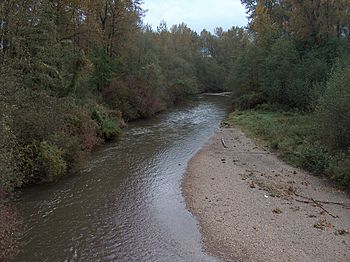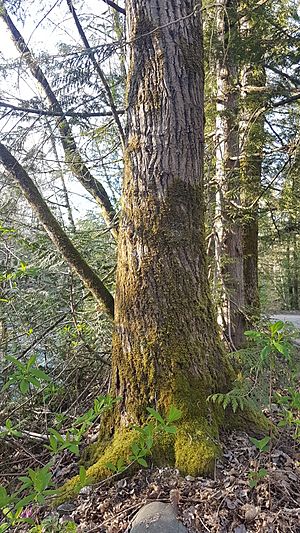Coquitlam River facts for kids
Quick facts for kids Coquitlam River |
|
|---|---|
 |
|
| Country | Canada |
| Province | British Columbia |
| Physical characteristics | |
| Main source | 1,034 m (3,392 ft) 49°33′13″N 122°45′59″W / 49.55361°N 122.76639°W |
| River mouth | Fraser River Port Coquitlam, Metro Vancouver 4 m (13 ft) 49°13′30″N 122°48′18″W / 49.22500°N 122.80500°W |
The Coquitlam River is a river in British Columbia, Canada. It flows into the Fraser River. The name "Coquitlam" comes from a local First Nations word, Kʷikʷəƛ̓əm. This word means "Red fish up the river," which refers to a type of sockeye salmon that used to live there.
The river is about 18 kilometers (11 miles) long and has 30 smaller streams, called tributaries, flowing into it. Because of its location, the river has had some big floods in the past.
The Kwikwetlem people were the first to live by the river. Later, settlers arrived and changed the river to use its resources. Today, the river is used to make hydro-electricity (power from water) with a dam.
Many groups are working to protect the river's mammals, birds, fish, and plants. They are trying to help salmon populations grow again using hatcheries. Some species in the area are even listed as endangered or at risk.
Contents
Where is the Coquitlam River?
The Coquitlam River is part of a larger area called the Coquitlam River Watershed. This watershed covers about 340 square kilometers (131 square miles). It was formed a very long time ago during the last ice age.
The river starts at Disappointment Lake, high up in the Coast Mountains. From there, it flows south into Coquitlam Lake. This lake is a large reservoir (a human-made lake) held back by the Coquitlam Dam. After the dam, the Coquitlam River continues south until it joins the Fraser River. This meeting point is between the cities of Coquitlam and Port Coquitlam.
The river flows for 18 kilometers (11 miles) from the dam to where it meets the Fraser River. Along its path, 30 smaller streams add water and sediment (like sand and gravel) to it. The Coquitlam River is a "meandering river," which means it has many bends and turns. You can see features like large rocks, fast-flowing shallow areas (called riffles), and banks that are worn away by the water.
The river's area gets a lot of rain, about 3,498 millimeters (138 inches) each year. This means the amount of water flowing in the river can change a lot. It can go from a normal flow to much higher levels after heavy rains. The biggest flood recorded happened in 1921, and another large one was in 1961.
Animals and Plants
The Coquitlam River is in a special natural area called the Coastal Western Hemlock biogeoclimatic zone. This means it has a specific type of climate and plants. The land around the river that hasn't been built on includes wetlands and small side channels. This "riparian habitat" (the area next to the river) has many different plants. You can find evergreen trees like western red cedars and trees that lose their leaves, like black cottonwoods.
This forested area provides a safe home for animals like black-tailed deer and raccoons, even though it's close to cities. The river and its smaller streams are home to 24 different kinds of fish, including 5 types of salmon. Salmon are very important to this ecosystem. They are food for animals like black bears and bald eagles. After salmon lay their eggs and die, their bodies break down and add nutrients to the soil, helping plants like salmonberries grow.
Animal Species
Scientists classify species based on how much they are at risk.
- Red list: Species that are in danger of disappearing.
- Blue list: Species that are of special concern, meaning they could become at risk.
- Yellow list: Species that are not currently at risk.
Here are some of the animals found in the Coquitlam River area:
Mammals
| Name | Species | Status |
|---|---|---|
| American black bear | Ursus americanus | Yellow |
| Black-tailed deer | Odocoileon hemionus | Yellow |
| Coyote | Canis latrans | Yellow |
| Racoon | Procyon lotor | Yellow |
| American Beaver | Castor canadensis | Yellow |
| Common Muskrat | Ondatra zibethicus | Yellow |
| American Mink | Neovison vison | Yellow |
Amphibians
| Name | Species | Status |
|---|---|---|
| Northern red-legged frog | Rana aurora | Blue |
Birds
| Name | Species | Status |
|---|---|---|
| Great blue heron | Ardea herodias | Blue |
| Bald eagle | Haliaeetus leucocephalus | Yellow |
| Red-tailed hawk | Buteo jamaicensis | Yellow |
| Wood duck | Aix sponsa | Yellow |
| Canada geese | Branta canadensis | Yellow |
| Merganser | Mergus merganser | Yellow |
| Black-capped chickadees | Poecile atricapillus | Yellow |
| Belted kingfisher | Megaceryle alcyon | Yellow |
| Spotted towhee | Pipilo maculatus | Yellow |
| Mallard duck | Anas platyrhynchos | Yellow |
| Varied thrush | Ixoreus naevius | Yellow |
| Winter wren | Troglodytes hiemalis | Blue |
Fish
| Name | Species | Status |
|---|---|---|
| Chinook salmon | Oncorhynchus tshawytscha | No Status |
| Pink salmon | Oncorhynchus gorbuscha | No Status |
| Steelhead trout | Oncorhynchus mykiss | No Status |
| Chum salmon | Oncorhynchus keta | No Status |
| Coho salmon | Oncorhynchus kisutch | No Status |
| Long-nosed dace | Rhinichthys cataractae | Yellow |
| Coastrange sculpin | Cottus aleuticus | Yellow |
| Prickly sculpin | Cottus asper | Yellow |
| Three-spined stickleback | Gasterosteus aculeatus | Yellow |
| Red-sided shiner | Richardsonius balteatus | Yellow |
| Northern squawfish | Ptychocheilus oregonensis | Yellow |
| Black crappie | Pomoxis nigromaculatus | Exotic |
| Pacific lamprey | Entosphenus tridentatus | Yellow |
Vegetation
| Name | Species | Status |
|---|---|---|
| Black cottonwood | Populus trichocarpa | Yellow |
| Red alder | Alnus rubra | Yellow |
| Pacific willow | Salix lasiandra var. lasiandra | Yellow |
| Vine maple | Acer circinatum | Yellow |
| Salmonberry | Rubus spectabilis | Yellow |
| Skunk cabbage | Lysichiton americanum | Yellow |
| Pacific ninebark | Physocarpus capitatus | Yellow |
| Western hemlock | Tsuga heterophylla | Yellow |
| Pacific silver fir | Abies amabilis | Yellow |
| Western red cedar | Thuja plicata | Yellow |
| Douglas fir | Pseudotsuga menziesii | Yellow |
| Himalayan blackberry | Rubus armeniacus | Exotic |
| Sword fern | Polystichum munitum | Yellow |
| Licorice fern | Polypodium glycyrrhiza | Yellow |
| English holly | Ilex aquifolium | Exotic |
| False lily-of-the-valley | Maianthemum dilatatum | Yellow |
| Red huckleberry | Vaccinium parvifolium | Yellow |
| Robert's geranium | Geranium robertianum | Exotic |
How People Use the River
A Look Back in Time
The Coquitlam River gets its name from the Kwikwetlem First Nations, who have lived in the area for at least 9,000 years. Their name, kʷikʷəƛ̓əm, means "Red fish up the river." This refers to the sockeye salmon that used to lay their eggs in Coquitlam Lake. The Kwikwetlem people were skilled at making canoes and paddles. They lived throughout the Coquitlam River area and relied on fishing, gathering plants, and trading with other First Nations along the Fraser River.
European settlers arrived in the mid-1800s and started using the river for their own needs. The first dam was built in 1892 at the entrance to Coquitlam Lake. This dam provided drinking water for the growing town of New Westminster. In 1905, a company built a second dam and a tunnel to nearby Buntzen Lake to create electricity. This meant a lot of the Coquitlam River's water was sent away, changing how the river flowed. Another, larger dam was finished in 1915. This dam completely blocked fish from reaching the lake, which greatly affected the river's natural life.
Throughout the 1900s, the area around the river was heavily logged (trees were cut down). This caused a lot of sand and gravel to wash into the river during heavy rains. In the 1950s and 60s, people also dug up gravel directly from the riverbed. This practice stopped in 1965.
The River Today
The Coquitlam Lake dam still provides power to people in Metro Vancouver. It is run by BC Hydro, the province's energy company. Coquitlam Lake is also one of three reservoirs that supply drinking water to 900,000 people in Metro Vancouver.
Because of the dam, less water flows in the river, and water is sent to Buntzen Lake. This affects the fish and wildlife living in and around the river. The dam acts as a barrier, stopping salmon from traveling between the upper and lower parts of the river. Salmon used to lay their eggs in the lake, but now they can't reach it. As a result, sockeye salmon have almost completely disappeared from the Coquitlam River. The dam also stops natural woody debris (like fallen trees) from building up in the lower river, which is important for creating fish habitats.
There are several popular parks and trails along the river, including Coquitlam River Park, Lions Park, and Gates Park. The river is also a favorite spot for local fishermen.
Protecting the River
Conservation Groups
Many groups have started projects to help the Coquitlam River and teach people about the problems it faces. These efforts began in 1996 and continue today with groups like the Coquitlam River Watershed Society (CRWS), which started in 1998.
Helping Salmon
To help salmon populations grow again, the Port Coquitlam & District Hunting and Fishing Club runs the Grist Goeson Memorial Hatchery. This hatchery is part of the Department of Fisheries and Oceans (DFO) Salmonid Enhancement Program. Each spring, tens of thousands of young fish are released from the hatchery. These efforts have helped coho, chum, and pink salmon numbers bounce back. There are now about four times more salmon returning than when their numbers were at their lowest. However, other types like sockeye salmon and steelhead trout are still not returning, or only in very small numbers. This is likely due to the long-term effects of the Coquitlam Lake dam, logging upstream, and gravel removal.
Since the dam was built, salmon have been cut off from the important areas where they used to grow up in the upper Coquitlam River. To try and fix this, Fisheries and Oceans Canada plans to move up to 100 returning coho salmon above the dam. This plan was suggested in 2020 and will likely be tested over five years. The Grist Goeson Memorial Hatchery will also help manage this project.
Protecting At-Risk Species
There is a special Wildlife Management Area located where the Coquitlam and Fraser Rivers meet. This land is managed by the BC's Ministry of Forests, Lands, Natural Resources Operations and Rural Developments. The great blue herons found here are a "blue-listed" species in BC, meaning they are of special concern. They are also listed as a "special concern" by COSEWIC.
In 2014, a project to protect at-risk species found both the great blue heron and the blue-listed red-legged frog along the Coquitlam River. Red-legged frogs were seen in the upper parts of the river. Scientists also found possible breeding areas for them and suggested restoring these spots. Because these amphibians are very sensitive, it was also suggested to avoid draining ponds or cleaning ditches during their breeding season.



